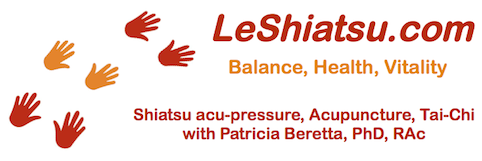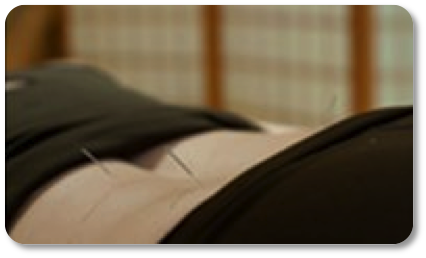Acupuncture is widely used worldwide because it is effective, non invasive, and natural.
Your Acupuncture treatment with Patricia Beretta, PhD, R.Ac.
Your acupuncturist, Patricia Beretta, focuses on alleviating challenging health issues that affect your quality of life. She first brings you to a place of greater comfort, and then supports you in your journey to health prevention and maintenance.
Patricia's Acupuncture style likely differs from what you have experienced before. She makes an assessment of your body that is very specific to you, not to the general disease you have. She verifies that her selection of acupuncture points works, before inserting needles. This way, you receive a very customized and effective treatment. Patricia is very gentle in her technique, and makes sure you remain comfortable at all stages of the treatment. She also
considers psycho-emotional challenges (if relevant and applicable), and all aspects of your lifestyle, such as nutrition and exercising, in order to recommend tailored self-care methods.
With her initial training in Shiatsu massage, Patricia developed a great sensitivity that enables her to find areas of pressure pain in your body. Some relate to your chief complaint, aka where it hurts, but many are actually reflexes that denote specific types of internal organ imbalances according the TCM, or according to the Japanese Acupuncture style from Kiiko Matsumoto that Patricia is using and continuously updates her skills in. This approach makes it possible to understand the systemic health imbalances that you are experiencing. In many cases, these systemic imbalances prevent proper healing, and re-balancing them will greatly contribute to alleviating your symptoms. Therefore a treatment for pain might include local points related to the painful area, might include points far from the pain area but related to it through a meridian's connection, but will most likely include points that re-balance your internal healing powers. For instance, treating neck pain might involve using points to re-balance the immune system (to deal with inflammation better), or digestion (to produce blood and energy that can noursih your muscles), or the TCM Liver (to promote free flow of Qi or produce blood to nourish your tendons), or the TCM Kidneys (to benefit the joints and the bones according to TCM), etc.
What should you expect during your Acupuncture treatment
Patricia schedules appointments every 90 minutes. Thank you for allowing time for your treatment and for scheduling and payment afterwards. For the first treatment, thank you for filling the initial intake and consent form before the treatment starts.
Only areas of your skin that need to be palpated for assessment and needled will be exposed. The room temperature is kept higher than the rest of the clinic, so that you stay comfortable and cozy throughout the treatments. Your own clothing, towels or sheets are used for draping, and your private areas are never exposed.
To prepare for your Acupuncture treatment, the following will greatly help:
- wear loose pants that can be moved up to expose your leg above the knee
- wear preferably a tank-top so that your arms, shoulders and neck can easily be accessed
- you can eat and drink, but please avoid a heavy meal, and stay away from alcohol
The treatment is done on a comfortable massage table, covered with flannel sheets, and consists of the main following phases:
- an assessment, with questioning, observation, tests, palpation of relevant diagnostic areas
- one or two needling sessions, for instance front and back, or 10 to 30 minutes each
- possibly a massage after the needling session(s), using acupressure and Tuina techniques
- a wrap-up discussion with self-care recommendation and planning for subsequent treatments
The number of treatments needed to make you feels better varies depending on your health condition and your constitution. In general, it takes 3 to 6 weekly treatments. More recent, and more acute issues usually take less time. Issues that started many years ago, chronic problems usually take longer. After results give you satisfaction, a monthly treatment for maintenance and prevention is a great approach in your wellness program. I usually advise people to come every 3 to 4 weeks in the winter, and 4 to 5 weeks in the summer for prevention because winter is usually harder for our system.
Adjunct treatment modalities during an Acupuncture treatment
Depending on your condition, adjunct modalities may be added to your Acupuncture treatment:
- Far Infrared Heat Lamp: in order to warm up a specific body part in its depth
- Moxibustion: the local application of heat on acu-points, using ancient methods with mugwort-based moxa. Moxibustion greatly helps strengthen the Qi-energy of a point, or disperse blockages
- Tuina: TCM acu-pressure massage, to loosen muscles and manually stimulate acu-points
- Cupping: to stimulate local blood flow, traditionally used for cough, asthma, or body pains
- Press-tacks, ear-seeds: mini pins or beans left on points to prolong the effect of the treatment
- Ear Acupuncture
- Scalp Acupuncture
Are there different types of Acupuncture?
Acupuncture from a Registered Acupuncturist
Acupuncturists are regulated healthcare professionals, and members of the College of Traditional Chinese Medicine Practitioners and Acupuncturists of Ontario, CTCMPAO. Their training is long and extensive, minimally 2,000 hours, and includes biomedicine, TCM diagnosis and treatment, 500 hours of clinical practicum, as well as exams related to safety and jurisprudence.
A Registered Acupuncturist, or R.Ac., uses the Traditional Chinese Medicine approach to diagnose mental and physical health imbalances, and safely insert thin needles in selected points in the meridians of acupuncture, in order to promote health, prevent and treat common diseases.
The body of knowledge from TCM is vast and deep, and Registered Acupuncturists may have a style that differs. Some will emphasize the regulation of Internal Organs, other of the Five Elements, for instance, but all work within the framework of common principles and health laws from texts and knowledge from ancient China.
Acupuncture provided by other regulated healthcare professionals
You may have received acupuncture from a chiropractor, physiotherapist, massage therapist or naturopath. In Ontario, seven other colleges allow their members to practice acupuncture, but only members of the CTCMPAO college can use the designation Acupuncturist.
Members from other colleges practice very good acupuncture. In general their training is a lot shorter, 150 to 300 hours (compared to 2000 hours). If they have a special interest for acupuncture and TCM, they will provide a service quite comparable to that of Registered Acupuncturists. But the art and science of acupuncture is complex and requires dedication and continuous effort to cultivate ones skills. It may happen that acupuncture from other healthcare professionals will tend to be more based on recipes (these points are good for shoulder pain for instance), as opposed to a thorough and deep understanding and personalization of the diagnosis and treatment based on all aspects of the person's health and lifestyle, and the rich body of knowledge from TCM.

